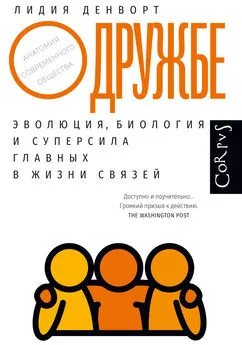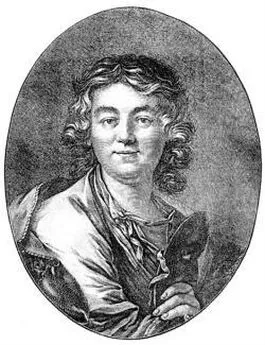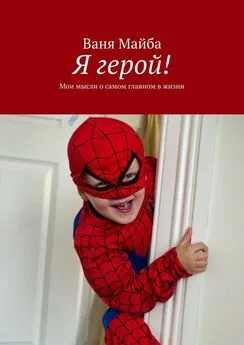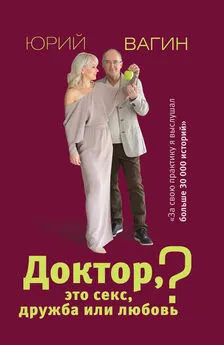Лидия Денворт - О дружбе. Эволюция, биология и суперсила главных в жизни связей
- Название:О дружбе. Эволюция, биология и суперсила главных в жизни связей
- Автор:
- Жанр:
- Издательство:неизвестно
- Год:2022
- Город:Москва
- ISBN:978-5-17-132612-8
- Рейтинг:
- Избранное:Добавить в избранное
-
Отзывы:
-
Ваша оценка:
Лидия Денворт - О дружбе. Эволюция, биология и суперсила главных в жизни связей краткое содержание
В формате a4.pdf сохранен издательский макет.
О дружбе. Эволюция, биология и суперсила главных в жизни связей - читать онлайн бесплатно ознакомительный отрывок
Интервал:
Закладка:
40
Tinbergen N. The Study of Instinct. Clarendon Press, 1951; Bateson P. and Laland K. Tinbergen’s Four Questions: An Appreciation and an Update . Trends in Ecology and Evolution. 2013. 28 (12): 712–718.
41
Lorenz K. Companions as Factors in the Bird’s Environment . Studies in Animal and Human Behavior. 1970. 1: 101–258; Hrdy. Mother Nature. P. 197 (photo).
42
Исследования Хайнда были подытожены в книге Боулби: Bowlby J., Separation: Anxiety and Anger. Basic Books, 1973. P. 60–74; см. также, например, Hinde R. and Spencer-Booth Y. Effects of Brief Separation from Mother on Rhesus Monkeys . Science. 1971. 173 (3992): 111–118.
43
Хайнд как наставник хорошо описан в книге: Peterson D., Jane Goodall, Chap. 19, и в книге Goodall J. et al. Remembering My Mentor .
44
Van Der Horst et al. John Bowlby .
45
Blum. Love at Goon Park. Обе цитаты взяты из “Введения” к изданию 2011 года.
46
Bowlby J. The Nature of the Child’s Tie to His Mother. International Journal of Psychoanalysis. 1958. 39: 350–373.
47
Bowlby J. Attachment. Basic Books, 1969/1982. P. 180.
48
Цит. по: Боулби Д. Привязанность . M.: Гардарики, 2003.
49
Ibid . P. 207–208.
50
Источники о работе Альтмана на острове Кайо: Wilson E. Naturalist. Island Press, 2013. Chap. 16; Lord of the Ants. Nova / WGBH by Windfall Films and Neil Patterson Production, 2008; Haraway. Primate Vision . Chap. 5.
51
“Мы на 95 % уверены…” Это говорит Альтман в фильме Lord of the Ants (“Повелитель муравьев”).
52
“Мне пришлось выбрать какой-то один… вид животных…”: Wilson. Naturalist . Chap. 1. Loc. 187. Kindle. В этих воспоминаниях описано также детство Уилсона.
53
Wilson. Naturalist . Chap. 10. Loc. 1955.
54
Zimmer K. Evolution: The Triumph of an Idea. Harper Collins, 2001. P. 86. Данная книга послужила также главным источником сведений для этой краткой истории научной мысли в области теории естественного отбора и наследственности.
55
Ibid . P. 93.
56
Материал для этой истории я почерпнула, помимо Циммера, у Уилсона из книги “Натуралист”; Naturalist . Chap. 7.
57
Слова самого Альтмана из фильма “Повелитель муравьев”.
58
Детали истории Кайо-Сантьяго взяты из многих интервью и из нескольких литературных источников. Самыми важными из них стали исторические статьи, написанные Кесслером и Роулинзом. Kessler and Rawlins. A 75 -Year Pictorial History ; Rawlins and Kessler. History of the Cayo ; Haraway. Primate Visions .
59
Рассказ Карпентера об устройстве колонии обезьян на Кайо-Сантьяго воспроизведен в книге Роулинза и Кесслера: Rawlins and Kessler. History of the Cayo . P. 14–21.
60
Цитируется по книге Haraway. Primate Visions. P. 93.
61
Altmann S. A Field Study of the Sociobiology of Rhesus Monkeys, Macaca mulatta . Annals of the New York Academy of Science, 1962.
62
Wilson. Naturalist. Chap. 16. Loc. 3884.
63
Ibid. Loc. 3897.
64
Фильм “Повелитель муравьев”.
65
“Что – вынуждены мы спросить…”: Wilson E. Sociobiology: The New Synthesis. Harvard University Press, 1975/2000. P. 1.
66
Wilson. Naturalist. Chap. 16. Loc. 3964.
67
Hamilton W. The Genetical Evolution of Social Behaviour I . Journal of Theoretical Biology. 1964. 7 (1): 1–16.
68
“…Совершенно не умел выступать перед аудиторией…”: это признание упоминается в сборнике статей Роберта Трайверса: Natural Selection and Social Theory: Collected Papers of Robert Trivers. Oxford University Press, 2002. P. 10.
69
Уилсон рассказывает об этом разговоре с Гамильтоном в Naturalist. Chap. 16.
70
Williams G. Adaptation and Natural Selection. Princeton University Press, 1966.
71
Trivers R. The Evolution of Reciprocal Altruism . Quarterly Review of Biology. 1971. 46 (1): 35–57.
72
Wilson. Sociobiology. Chap. 1. Loc. 17102.
73
“Сравнивая человека…” Ibid. Chap. 27. Loc. 17102.
74
Allen E. et al. Against ‘Sociobiology’ . New York Review of Books. 1975. November 13.
75
Rensberger B. Sociobiology: Updating Darwin on Behavior . New York Times. 1975. May 28. P. 1.
76
Why You Do What You Do . Time. 1977. August 1.
77
Hrdy S. Mothers and Others: The Evolutionary Origins of Mutual Understanding. Harvard University Press, 2009. P. 6.
78
Konner. Evolution of Childhood. P. 89.
79
Интервью автора с Марком Джонсоном.
80
Bowlby. Attachment. P. 265.
81
Лекции Канвишер можно послушать и посмотреть на сайте МИТ по адресу: https: // nancysbraintalks.mit.edu / video / humans-are-highly-social-species .
82
MacLean P. and Kral V. A Triune Concept of the Brain and Behaviour. University of Toronto Press, 1973.
83
Собирая сведения о социальном мозге, я опиралась на многочисленные интервью, лекции и литературные источники, например, на работы Майкла Платта, Талии Уэтли, Кэролин Паркинсон и Ральфа Адольфса; Tremblay S. et al. Social Decision-Making and the Brain: A Comparative Perspective. Trends in Cognitive Sciences. 2017. 21 (4): 265–276; Parkinson C. and Wheatley T. The Repurposed Social Brain . Trends in Cognitive Sciences. 2015. 19 (3): 133–41; Adolphs R. The Social Brain: Neural Basis of Social Knowledge . Annual Review of Psychology. 2009. 60: 693–716.
84
Интервью автора с Сарой Ллойд-Фокс.
85
Johnson M., Bolhuis J., and Horn G. Interaction between Acquired Preferences and Developing Predispositions during Imprinting . Animal Behaviour. 1985. 33 (3): 1000–1006.
86
Johnson M. Memories of Mother . New Scientist. 1988. 117 (1600): 60–62.
87
Jones W. and Klin A. Attention to Eyes Is Present but in Decline in 2–6 -month-old Infants Later Diagnosed with Autism . Nature. 2013. 504 (7480): 427.
88
Jenkins R., Dowsett A., and Burton A. How Many Faces Do People Know? Proceedings of the Royal Society B. 2018. 285 (1888): 20181319.
89
Barrett L. How Emotions Are Made: The Secret Life of the Brain. Houghton, Mifflin Harcourt, 2017.
90
Goren C. et al. Visual Following and Pattern Discrimination of Face-like Stimuli by Newborn Infants . Pediatrics. 1975. 56 (4): 544–549.
91
Johnson M. et al. Newborn Preferential Tracking of Face-like Stimuli and Its Subsequent Decline. Cognition. 1991. 40 (1–2): 1–19.
92
Выступление Нэнси Канвишер на TED-конференции, март 2014 года.
93
Kanwisher N. et al. The Fusiform Face Area: A Module in Human Extrastriate Cortex Specialized for Face Perception . Journal of Neuroscience. 1997. 17 (11): 4302–4311.
94
Arcaro M. et al. Seeing Faces Is Necessary for Face-Domain Formation . Nature Neuroscience. 2017. 20 (10): 1404.
95
“…Проводя свой первый эксперимент…”: Lloyd-Fox S. et al. Social Perception in Infancy: A Near Infrared Spectroscopy Study . Child Development. 2009. 80 (4): 986–999.
96
Lloyd-Fox S. et al. Cortical Specialization to Social Stimuli from the First Days to Second Year of Life: A Rural Gambian Cohort . Developmental Cognitive Neuroscience. 2017. 25: 92–104.
97
Eliot L. What’s Going on in There? How the Brain and Mind Develop in the First Five Years of Life. Bantam Books, 1999. Chap. 10.
98
Lloyd-Fox S. et al. The Emergence of Cerebral Specialization for the Human Voice over the First Months of Life . Social Neuroscience. 2012. 7 (3): 317–330.
99
Интервью автора с Дэниелом Абрамсом; Abrams D. et al. Neural Circuits Underlying Mother’s Voice Perception Predict Social Communication Abilities in Children . Proceedings of the National Academy of Sciences. 2016. 113 (22): 6295–6300.
100
Denworth L. The Social Power of Touch. Scientific American Mind. 2015. 26 (4): 30–39.
101
Интервью автора с Хоканом Олафссоном.
102
Помимо интервью с Хоканом Олафссоном и Фрэнсисом Макглоном, я почерпнула информацию на эту тему в литературе о нежных любовных прикосновениях – например, в статье McGlone F. et al. Discriminative and Affective Touch: Sensing and Feeling. Neuron. 2014. 82 (4): 737–755; Löken L. et al. Coding of Pleasant Touch by Unmyelinated Afferents in Humans . Nature Neuroscience. 2009. 12 (5): 547.
Читать дальшеИнтервал:
Закладка:





![Юрий Вагин - Доктор, это секс, дружба или любовь? [Секреты счастливой личной жизни от психотерапевта] [litres]](/books/1073262/yurij-vagin-doktor-eto-seks-druzhba-ili-lyubov-s.webp)




